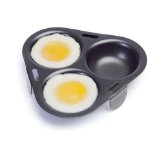I found a great recipe for vegetable and cheese cannelloni a few weeks ago and it called for fresh ricotta. Not wanting to hunt all over for the expensive and elusive fresh ricotta (quite different and better than the ricotta you can find in any grocery), I decided to make my own. By the way, I will provide the cannelloni recipe another day. It’s great.
There are many internet and you tube resources for making various cheeses and I looked over many of them. The simplest method required only whole milk, an acid, either vinegar or lemon juice, and salt. Some recipes called for the addition of a little heavy cream for extra flavor and, well, “creaminess”. I had everything on hand so I gave it a go. (Note: The resulting cheese from this recipe is more like an Indian paneer than true ricotta, but it works perfectly in recipes calling for ricotta and it’s delicious on its own.)
For safety reasons, the milk needs to be heated to at least 185 degrees, Fahrenheit. I poured the whole milk into a heavy-bottomed stainless steel soup pot to which I added a cup of heavy cream and a tablespoon of salt. Using a candy thermometer attached to the side of the pot, I slowly heated the mixture, stirring nearly constantly, until the milk simmered, steamed and reached 190-200 degrees. For a gallon of milk, this took about 15 minutes on my electric stove. At that point, I turned off the heat, and stirred in 6 tablespoons of lemon juice. Rather quickly, the curds and whey began to separate.
After 5-10 minutes it was time to strain away the whey. There are a few easy ways to accomplish this without buying any cheese-making aparatus or using yards of folded over cheesecloth. I find the easiest way is to use a man’s cotton or linen handkerchief, clean of course, and rinsed with water, placed over a medium sized colander or strainer. I have also used a #4 coffee filter in a strainer, but it doesn’t hold a lot. The handkerchief is at least 12 inches square and easily fits in my large colander with the corners hanging over the rim of the colander.
Whichever straining method is used, you must place the strainer over a bowl large enough to catch the hot whey. You will have much more whey than cheese and if your bowl isn’t large enough to hold it all, you will need a second bowl close by. You can also put the colander in the sink and let the whey go down the drain. (Remember that the curds and whey are very hot.) Carefully pour the contents of the pan into the colander or strainer. At this point, you can let it stand to complete the draining away of the liquid. This can take 30 minutes or so, depending on how dry you want the curds. You can hurry the process by bringing up the ends of the handkerchief, twisting them around to force the cheese to release more liquid. The ball of cheese will be hot for quite a while, so be careful if you use your bare hands to squeeze out the liquid. Once the draining is complete, you can scrape the cheese off the cloth and into a container. I usually let it cool an hour or so on the counter before refrigerating it.
A gallon of milk will produce about 2 cups of cheese. Of course you can always make a smaller amount. If you don’t need that much for a specific recipe, the rest of the cheese can be flavored with some chopped herbs for a savory cheese spread for bruschetta or any other bread. You can also make a sweet cheese spread by adding honey; this would be good on biscuits.
With no preservatives, the cheese must be refrigerated and used within 3 or 4 days. If you have milk that is nearing it’s expiration date, this is a great way to avoid wasting it. I have saved some of the whey and used it as the liquid for baking bread. It can also be used in soup recipes.




 Now, I use my handy-dandy
Now, I use my handy-dandy 
 Did you ever go to your refrigerator to look for something you positively knew was in there only to find 23 things you forgot you had and never finding what you were looking for until you moved that plastic container shoved wa-a-a-y in the back? You know, that “science experiment” about growing mold?
Did you ever go to your refrigerator to look for something you positively knew was in there only to find 23 things you forgot you had and never finding what you were looking for until you moved that plastic container shoved wa-a-a-y in the back? You know, that “science experiment” about growing mold? 